OCZ has taken market stratification to its textbook definition with their ever growing SSD family. Within the SATA 6Gb/s space, they offer four drives (in order of performance) including the Vertex 3 Max IOPS, Vertex 3, Agility 3 and our subject today, the Solid 3. Being at the back of the line though isn’t always a bad thing; consumers need performance across the scale and the Solid 3 solves one key issue – price. While not blazing fast like it’s brothers, the Solid 3 delivers respectable 500MB/s read speeds, 450MB/s writes and 20,000 random write 4K IOPS.
When it comes to thinking about the market for the Solid 3, it’s important to understand the differences between it and the Agility 3, it’s closest member on the OCZ family tree. On paper they’re very similar with the Solid 3 markedly less showy on the IOPS figure, quoting just 40% of the Agility 3. From a hardware perspective, they’re nearly identical, both use the same SandForce SF-2281 controller and SATA 6Gb/s interface. The big change comes in firmware and NAND. The Solid 3’s slower firmware allows OCZ to use more cost effective NAND when available. While our review unit has Intel/Micron NAND, the tightened IOPS requiremement means OCZ could conceivably use Hynix, Toshiba or other brands of NAND as they’re available. The other minor change is the Solid 3 only comes in 60GB and 120GB capacities, where the Agility 3 goes up to 240GB.
On the spec sheet the Solid 3 has similar straight line speeds to the rest of the family, the most obvious difference being in IOPS potential. We’ll dive further into the Solid 3’s performance against the rest of the OCZ family in this review to see just where it comes out.
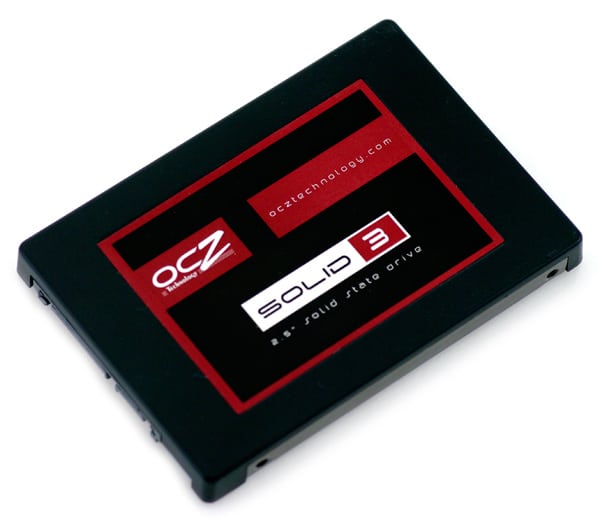
OCZ Solid 3 Specs
- Available capacities: 60GB and 120GB
- 120GB Formatted Capacity – 111.79GB
- SATA 6Gb/s interface
- SandForce SF-2281 Controller
- Max Sequential Speeds: up to 500MB/s Read and up to 450MB/s Write
- Random Write 4KB (Aligned): 20,000 IOPS
- 25nm Intel/Micron asynchronous MLC NAND
- Power Consumption: 2.7W Active, 1.5W Idle
- MTBF: 2 million hours
- 3-Year Warranty
Aesthetics
The Solid 3 uses the newer SSD design that OCZ adopted a few months ago. This design makes use of a plastic cover and metal plate, where the older model had a metal body with a flat metal plate screwed into place. Both designs look very attractive.
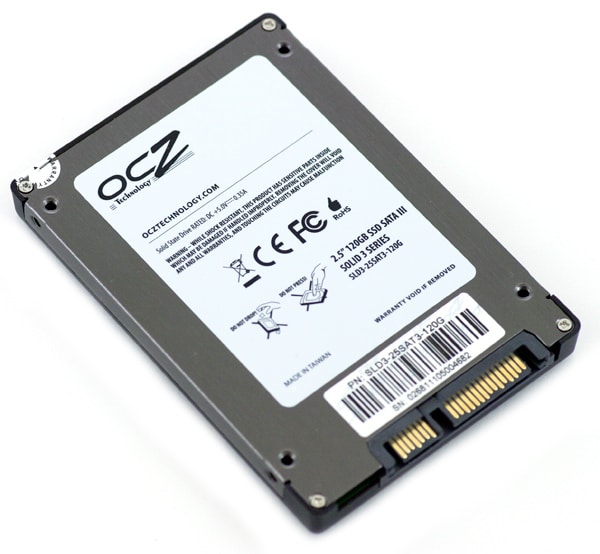
Besides the case itself changing, nothing else from the outside seems to indicate these drives are any different than the past models. The stickers and branding are identical, as well as the information stickers on the back. Comparing the Vertex 3 to the Solid 3, users will note the different color schemes used on each model. Whereas the Vertex 3 makes use of silver or the Agility 3 uses green, the Solid 3 offers a red and black color combination.

The front of the drive features a standard SATA power and data connection, with no debug pins next to the connector.
Disassembly
As a warning for those thinking about tearing into their new OCZ Solid 3, know that you void your warranty in the process. Besides trying to get a physical confirmation on what the internals are, there really is no reason to open one of these up during normal usage.
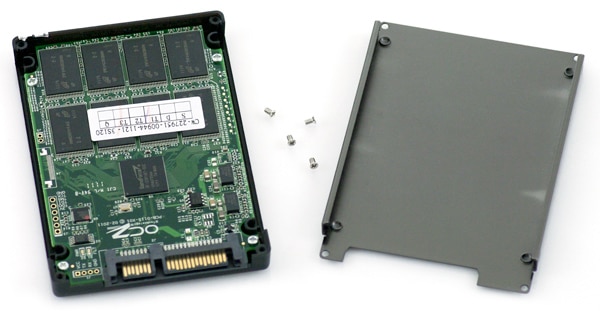
The OCZ Solid 3 is very easy to take apart with a Phillips-head screwdriver. After removing four screws around the perimeter and breaking through the warranty sticker, the top cover comes loose exposing the PCB inside. The circuit board is held in place with four additional screws, although the primary guts of the drive are on top.
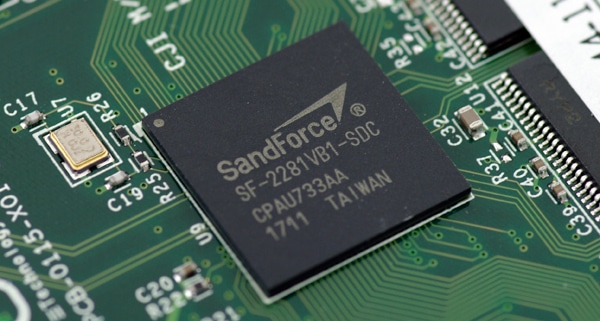
At the heart of the OCZ Solid 3 SSD is the same SandForce SF-2281VB1-SDC controller also found on the Vertex 3 and Agility 3. SandForce processor SSDs interact directly with the flash modules, without a buffer, meaning no board space is taken up by RAM. This also helps save on power and also helps reduce overall size when you shrink the entire layout down to micro-levels.
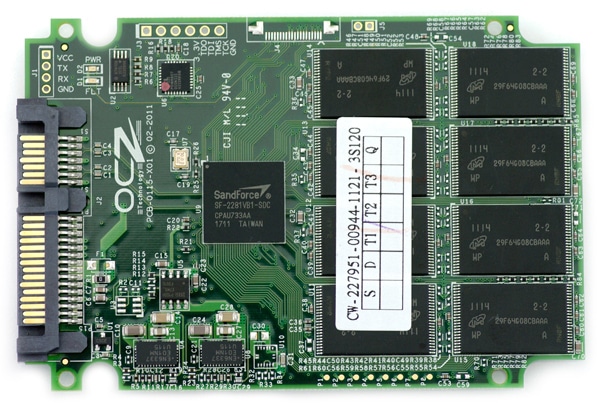
Compared to the regular OCZ Vertex 3 which uses 25nm synchronous NAND, the Solid 3 makes use of sixteen Micron 29F64G08CBAAA 8GB 25nm asynchronous NAND pieces.
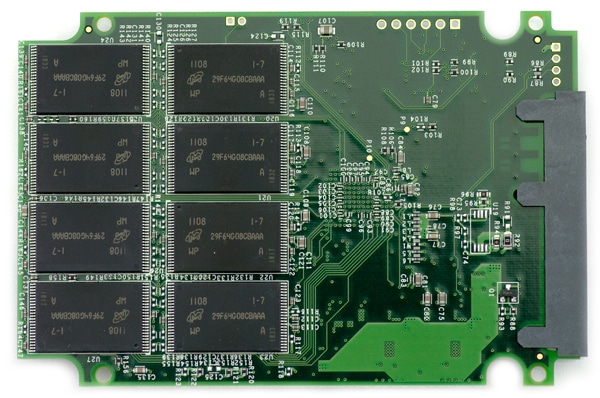
Synthetic Benchmarks
To keep things short and simple, we stacked the OCZ Solid 3 against the three other OCZ SF-2200 offerings. These include the top-performing OCZ Max IOPS, high-performance OCZ Vertex 3, and the mainstream Agility 3. All of these models are centered around the same SandForce processor, but what makes each model unique is the type of NAND flash or firmware the controllers are operating with. The Solid 3 offers the same type of flash as the Agility 3, although is partially held back in some areas to be positioned and priced as a budget-friendly performance model.
The 120GB OCZ Solid 3 is rated with a peak read speed of 500MB/s and a write speed of 450MB/s. To put these claims to the test we start off by looking at the performance using a 2MB sequential transfer test in IOMeter looking at both repeating and random data.
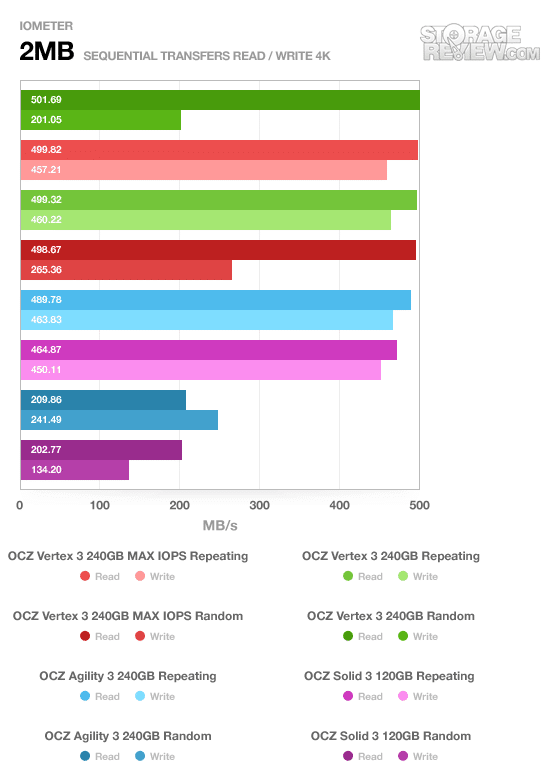
The Solid 3 came up slightly under the rated mark, measuring just 465MB/s read, but nailed it on write speed with 450MB/s on the dot with repeating data. Changing the test pattern to a fully randomized stream the speeds dropped to 202MB/s read and 134MB/s write, falling below the Agility 3.
Our next test looks at random transfer speeds, keeping the same 2MB request size.
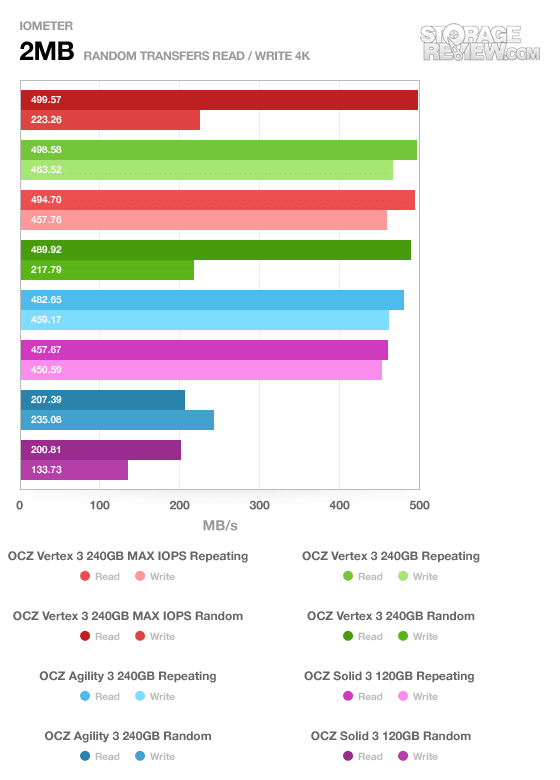
The Solid 3 still stayed at the bottom of the pack, but very close to the Agility 3, measuring 457MB/s read and 450MB/s write. With fully randomized data those speeds dropped to 200MB/s read and 133MB/s write.
Now the 4K transfer test is the big differentiating factor between the Solid 3 and the other SF-2200 models that OCZ sells. In this area, while the others could be considered unlimited, the Solid 3 is throttled back to just 20k IOps.
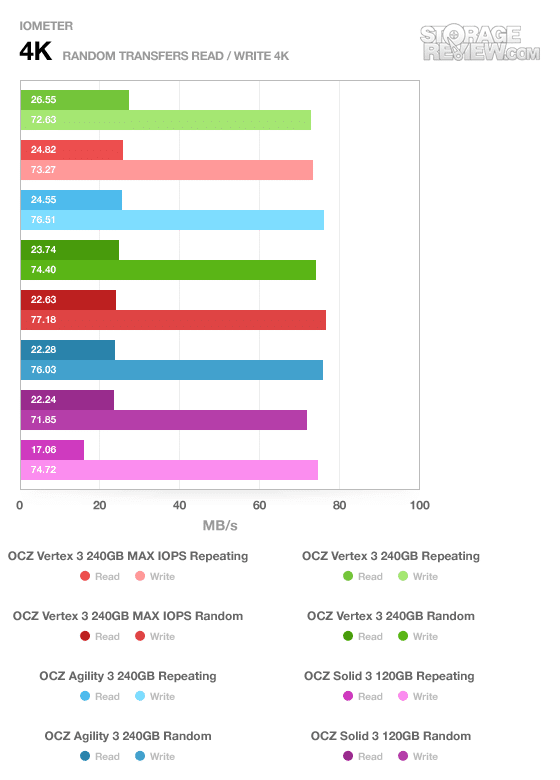
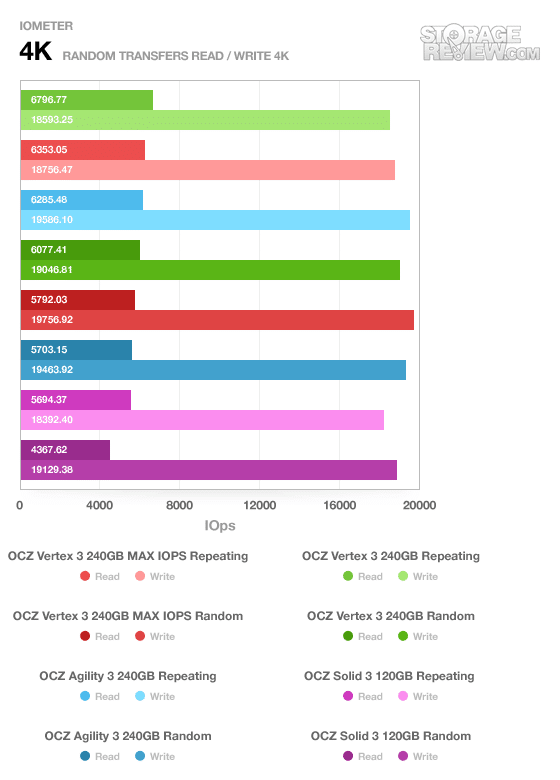
Even with the 20K random write limit, you won’t really notice a difference at a queue depth of one. While the Solid 3 came in at the bottom of the pack, it wasn’t *that* much slower than any of the other models in read or write speed. The one area the Solid 3 fell below the pack by a good margin was in our randomized data test where read speeds dropped to 17MB/s from 22MB/s in the prior test.
To get the clearest picture of what the firmware 20k limit means, nothing shows it better than our ramped 4K write test. In this we show performance scaled from a queue depth of one all the way up to 64.
In the first segment the Solid 3 stayed right with the pack up to a queue depth of 4, and then flat-lined at 22-24k.
The expanded write test is where things get really interesting. In the jump to a queue depth of 2, the Solid 3 actually lead the pack right alongside the Agility 3, measuring 49k IOps, but comes crashing down to 20.8k in all higher stages. The randomized data test showed a similar jump, although not nearly as pronounced.
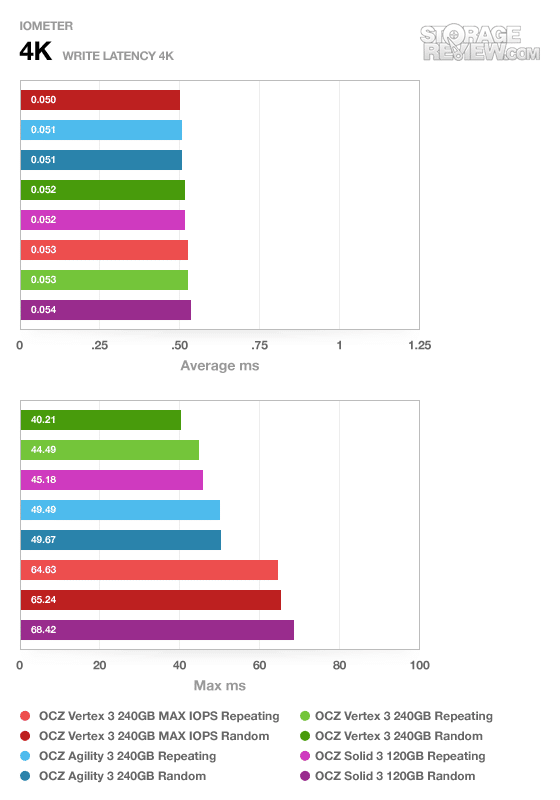
Given the near-identical components, it wasn’t a huge surprise to see the average 4K write response times so closely grouped together. On max latency the Solid 3 did come in with the highest time on with the randomized data, but just barely above the Vertex 3.
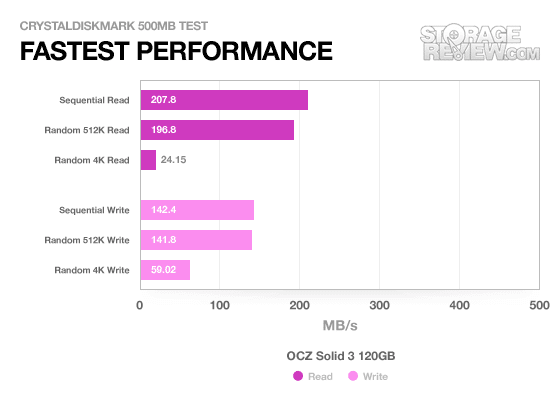
Running CrystalDiskMark with random data, we found very similar speeds to our IOMeter tests.
Our last section of synthetic benchmarks covers standard IOMeter server profiles, with a queue depth spanning from 1 to 128. In similar fashion to the expanded 4K read and write tests, the Solid 3 stayed toward the bottom of the pack.
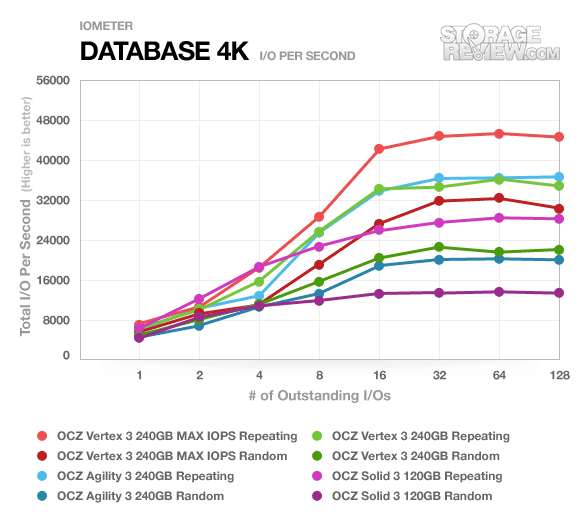
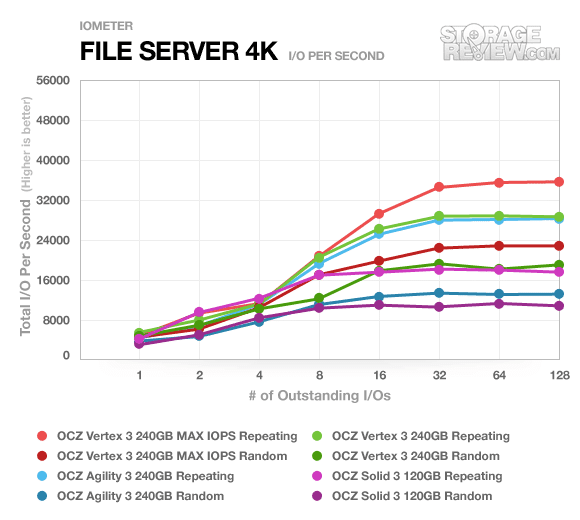
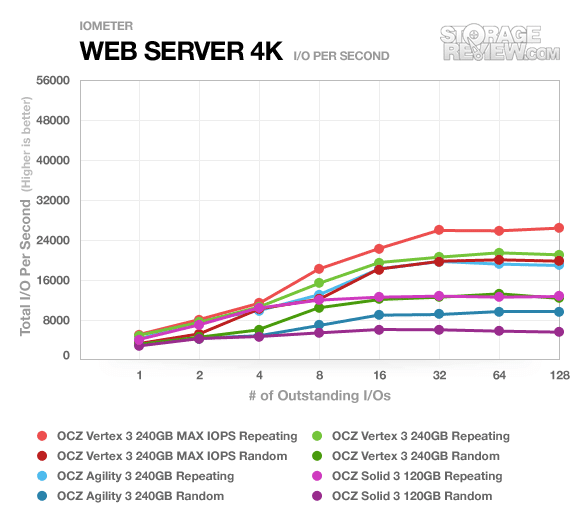
Real-World Benchmarks
If you are new to StorageReview, one thing we try to focus on is how any given drive might perform under real-world conditions. For the average user, trying to translate random 4K write speeds into an everyday situation is pretty difficult. It helps when comparing drives in every setting possible, but it doesn’t exactly work out into faster everyday usage or better game loading times. For this reason we turned to our StorageMark 2010 traces, which include HTPC, Productivity, and Gaming traces to help readers find out how a drive might rank under their conditions.
Staying in line with our synthetic benchmarks, we kept the same comparison group of all four OCZ SF-2200 equipped SATA drives. Given how similar the Solid 3 scored in our first round of tests, it will be interesting to see how that plays out in our real-world traces.
The first real-life test is our HTPC scenario. In this test we include: playing one 720P HD movie in Media Player Classic, one 480P SD movie playing in VLC, three movies downloading simultaneously through iTunes, and one 1080i HDTV stream being recorded through Windows Media Center over a 15 minute period. Higher IOps and MB/s rates with lower latency times are preferred. In this trace we recorded 2,986MB being written to the drive and 1,924MB being read.
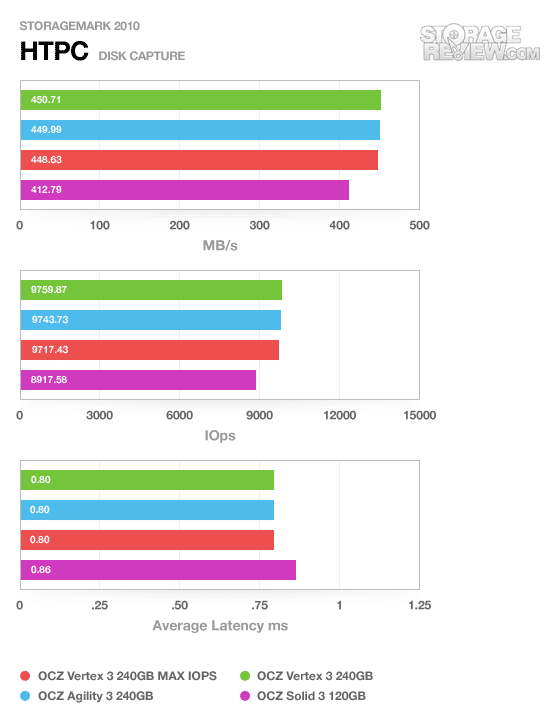
In the HTPC trace we start to see the Solid 3 finally start slipping behind the other models. Whereas most were in the 450MB/s range, the Solid 3 came in with an average transfer speed of 412MB/s or roughly 8% slower than the lead drive.
Our second real-life test covers disk activity in a productivity scenario. For all intents and purposes this test shows drive performance under normal daily activity for most users. This test includes: a three hour period operating in an office productivity environment with 32-bit Vista running Outlook 2007 connected to an Exchange server, web browsing using Chrome and IE8, editing files within Office 2007, viewing PDFs in Adobe Reader, and an hour of local music playback with two hours of additional online music via Pandora. In this trace we recorded 4,830MB being written to the drive and 2,758MB being read.
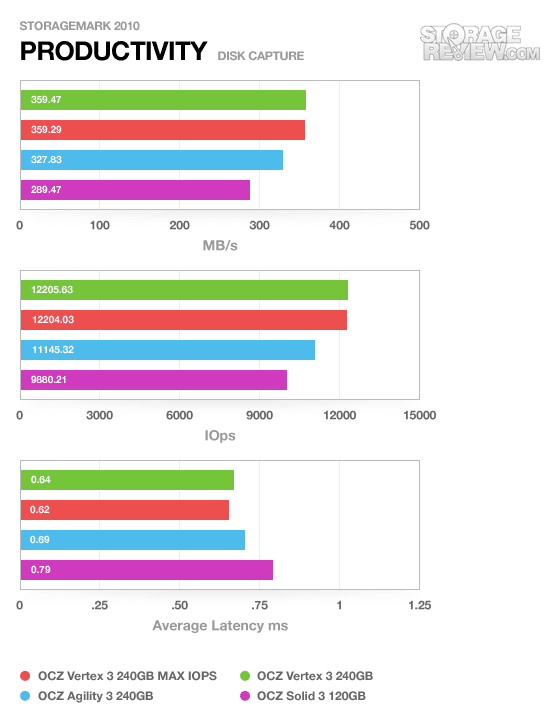
In our Productivity trace we see a similar drop-off, with an average speed of 289MB/s compared to 327MB/s with the Agility 3 or 359MB/s from the Vertex 3 models. The Solid 3 comes in 11.6% slower than the Agility and 19.5% slower than the Vertex 3 models. Still fairly impressive given the budget nature of this drive.
Our third real-life test covers disk activity in a gaming environment. Unlike the HTPC or Productivity trace, this one relies heavily on the read performance of a drive. To give a simple breakdown of read/write percentages, the HTPC test is 64% write, 36% read, the Productivity test is 59% write and 41% read, while the gaming trace is 6% write and 94% read. The test consists of a Windows 7 Ultimate 64-bit system pre-configured with Steam, with Grand Theft Auto 4, Left 4 Dead 2, and Mass Effect 2 already downloaded and installed. The trace captures the heavy read activity of each game loading from the start, as well as textures as the game progresses. In this trace we recorded 426MB being written to the drive and 7,235MB being read.
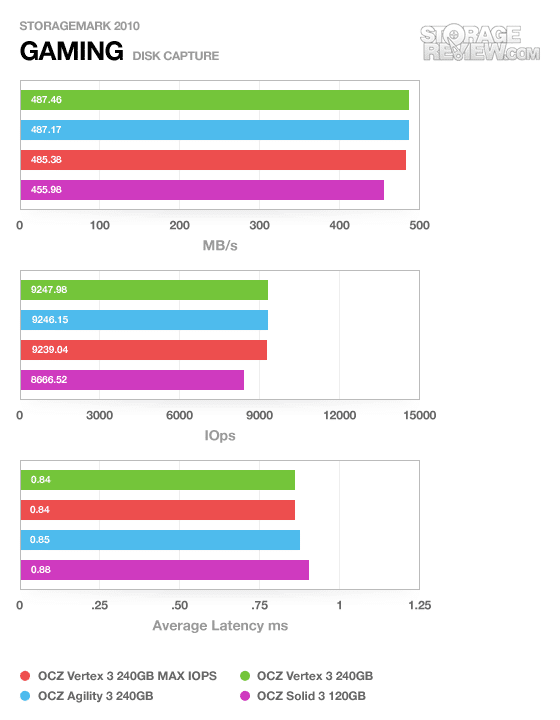
In the third and final Gaming trace, the Solid 3 still trailed the rest of the pack, but just by 6.5%. Still very respectable given the pricing structure of this model.
Power Consumption
It seems as though each new SandForce SF-2200 SSD we look at, the power consumption keeps getting less and less. The first big drop we measured was the switch from our pre-release Vertex 3 to the retail version took most values down by a factor of two or three. Next it was with the MAX IOPS version, with its toggle NAND offering faster speeds while conserving power over 25nm flash. Now we see yet another drop going from those models to the asynchronous NAND powered Solid 3.
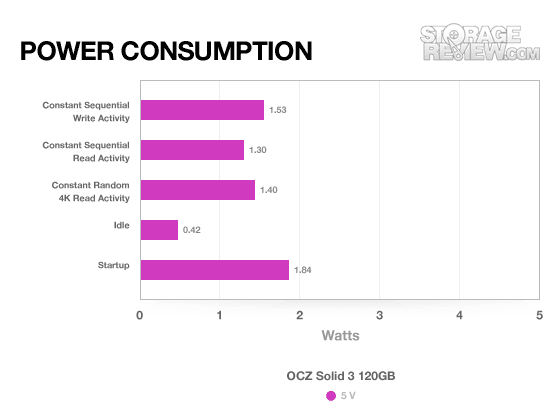
Idle power consumption measured 0.42 watts, with a peak draw of 1.84 watts at startup. Constantly sequential write activity measured 1.53 watts, with read activity spanning from 1.30 to 1.40 watts depending on a sequential or random 4k load.
Warranty
OCZ offers an industry standard 3-year warranty on the Solid 3 SSD. Currently the only mainstream-grade SSD to top this figure is the Intel SSD 320, which offers a five-year warranty. OCZ backs their products with a wide range of support options, ranging from standard technical support to a strong community-based support forum.
Conclusion
The OCZ Solid 3 hits two points that we always like to see in a product; low price and strong performance. With a street price of $120 and $220 for the 60GB and 120GB OCZ Solid 3 SSDs, there’s a lot to like based on price tag alone. Performance is limited compared to the Agility 3 or Vertex 3, but in our real-world traces it still only trailed by 6.5-19.5% depending on the situation. A “budget” drive hanging with the fastest drives on the market is hard to overlook.
Given the internals of the OCZ Solid 3, its not a huge surprise we saw the strong performance that we did. It includes the same tried and true SF-2200 processor and a full-bandwidth 16-chip NAND configuration, with the only thing holding it back being a firmware limiter. In many ways you could argue that the jump to the Agility 3 could be worth it for a set of people, but if saving money is paramount, many people probably wouldn’t notice the real world performance difference. For shoppers looking for the budget SSD with the most bang for their buck, OCZ really offers one heck of a deal with the Solid 3.
Pros
- Very strong performance on a “budget” SSD
- Not a huge performance drop in some areas compared to Vertex 3
- Lowest priced SF-2200 SSD
Cons
- Depending on current sale price, might be worth buying Agility 3 instead.
Bottom Line
The OCZ Solid 3 rounds out a lineup of SSDs where OCZ offers something for everyone. The Solid 3 truly is “everyman’s SSD” – offering an aggressive price point starting at just $120 that easily laps the other budget-SSD offerings currently available. While not the fastest SSD around, that’s not the point – the Solid 3 offers up class-leading performance at a price that’s cheaper than even prior generation SandForce offerings.



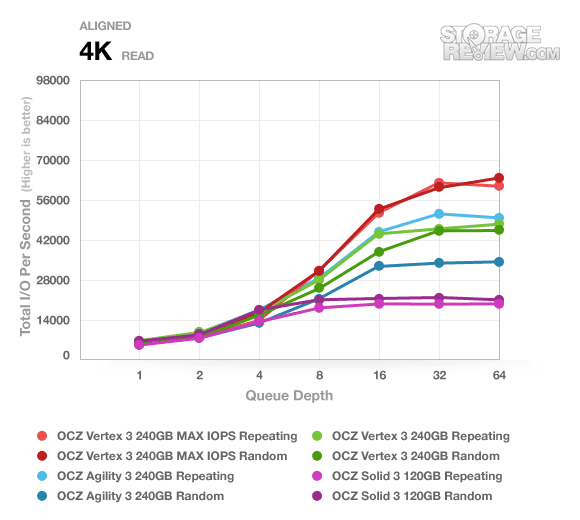
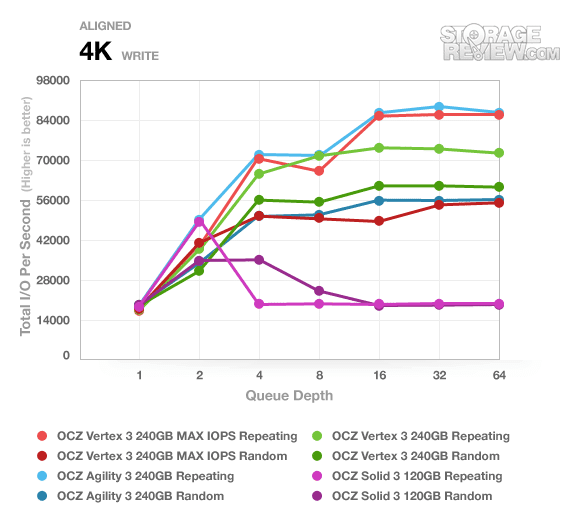
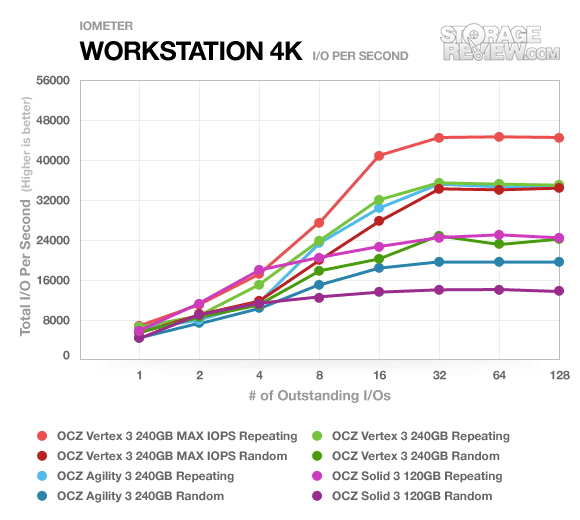


 Amazon
Amazon